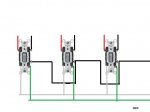Ok, that being said, here's what a little research has turned up:
- Neither Cerrowire, Nexans or Southwire (all available locally) have any instructions regarding the installation or termination of their NM-B products on their websites.
- Neither Ideal, Gardner-Bender or NSI industries has any instructions for the proper use of their 10-32 ground screws (some are UL listed, though).
- The instructions for the most common dimmer in most houses, a Lutron AY600P, includes an illustration and instructions for attaching a loop of wire to the screw terminal when it exists:
View attachment 7197
(pdf available
here with illustration in step 3)
While I understand your argument and your concern for safety as an inspector, I can find no indication other than omittance of the technique in some instruction sheets that it would be forbidden. Omittance is not a clear argument against loops.


